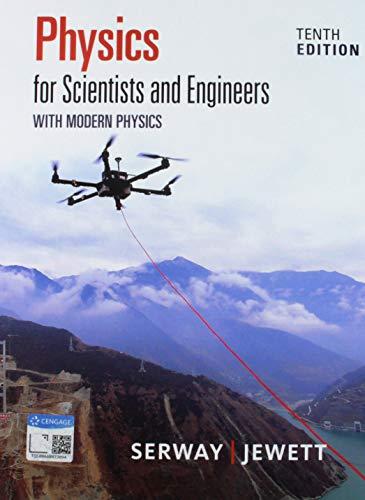
Concept explainers
A uniformly charged ring of radius 10.0 cm has a total charge of 75.0 μC. Find the electric field on the axis of the ring at (a) 1.00 cm, (b) 5.00 cm, (c) 30.0 cm, and (d) 100 cm from the center of the ring.
(a)
The electric field on the axis of a ring at
Answer to Problem 3P
The electric field on the axis of a ring at
Explanation of Solution
Given info: The radius of the uniformly charged ring is
From the Coulomb’s law the formula to calculate the electric field at any distance on the axis due to a uniformly charged ring.
Here,
The proportionality constant
Here,
Substitute
The charge on the ring is positive so the direction of the electric field is away from the center of the ring.
Substitute
Conclusion:
Therefore, the electric field on the axis of a ring at
(b)
The electric field on the axis of a ring at
Answer to Problem 3P
The electric field on the axis of a ring at
Explanation of Solution
Given info: The radius of the uniformly charged ring is
The charge on the ring is positive so the direction of the electric field is away from the center of the ring.
Substitute
Conclusion:
Therefore, the electric field on the axis of a ring at
(c)
The electric field on the axis of a ring at
Answer to Problem 3P
The electric field on the axis of a ring at
Explanation of Solution
Given info: The radius of the uniformly charged ring is
The charge on the ring is positive so the direction of the electric field is away from the center of the ring.
Substitute
Conclusion:
Therefore, the electric field on the axis of a ring at
(d)
The electric field on the axis of a ring at
Answer to Problem 3P
The electric field on the axis of a ring at
Explanation of Solution
Given info: The radius of the uniformly charged ring is
The charge on the ring is positive so the direction of the electric field is away from the center of the ring.
Substitute
Conclusion:
Therefore, the electric field on the axis of a ring at
Want to see more full solutions like this?
Chapter 23 Solutions
Bundle: Physics For Scientists And Engineers With Modern Physics, 10th + Webassign Printed Access Card For Serway/jewett's Physics For Scientists And Engineers, 10th, Multi-term
Additional Science Textbook Solutions
Anatomy & Physiology (6th Edition)
Biology: Concepts and Investigations
Organic Chemistry (8th Edition)
Cosmic Perspective Fundamentals
Genetics: From Genes to Genomes
- Which of the following best describes how to calculate the average acceleration of any object? Average acceleration is always halfway between the initial acceleration of an object and its final acceleration. Average acceleration is always equal to the change in velocity of an object divided by the time interval. Average acceleration is always equal to the displacement of an object divided by the time interval. Average acceleration is always equal to the change in speed of an object divided by the time interval.arrow_forwardThe figure shows the velocity versus time graph for a car driving on a straight road. Which of the following best describes the acceleration of the car? v (m/s) t(s) The acceleration of the car is negative and decreasing. The acceleration of the car is constant. The acceleration of the car is positive and increasing. The acceleration of the car is positive and decreasing. The acceleration of the car is negative and increasing.arrow_forwardWhich figure could represent the velocity versus time graph of a motorcycle whose speed is increasing? v (m/s) v (m/s) t(s) t(s)arrow_forward
- Unlike speed, velocity is a the statement? Poisition. Direction. Vector. Scalar. quantity. Which one of the following completesarrow_forwardNo chatgpt pls will upvote Already got wrong chatgpt answerarrow_forward3.63 • Leaping the River II. A physics professor did daredevil stunts in his spare time. His last stunt was an attempt to jump across a river on a motorcycle (Fig. P3.63). The takeoff ramp was inclined at 53.0°, the river was 40.0 m wide, and the far bank was 15.0 m lower than the top of the ramp. The river itself was 100 m below the ramp. Ignore air resistance. (a) What should his speed have been at the top of the ramp to have just made it to the edge of the far bank? (b) If his speed was only half the value found in part (a), where did he land? Figure P3.63 53.0° 100 m 40.0 m→ 15.0 marrow_forward

 Principles of Physics: A Calculus-Based TextPhysicsISBN:9781133104261Author:Raymond A. Serway, John W. JewettPublisher:Cengage Learning
Principles of Physics: A Calculus-Based TextPhysicsISBN:9781133104261Author:Raymond A. Serway, John W. JewettPublisher:Cengage Learning Physics for Scientists and Engineers: Foundations...PhysicsISBN:9781133939146Author:Katz, Debora M.Publisher:Cengage Learning
Physics for Scientists and Engineers: Foundations...PhysicsISBN:9781133939146Author:Katz, Debora M.Publisher:Cengage Learning Physics for Scientists and Engineers with Modern ...PhysicsISBN:9781337553292Author:Raymond A. Serway, John W. JewettPublisher:Cengage Learning
Physics for Scientists and Engineers with Modern ...PhysicsISBN:9781337553292Author:Raymond A. Serway, John W. JewettPublisher:Cengage Learning Physics for Scientists and Engineers, Technology ...PhysicsISBN:9781305116399Author:Raymond A. Serway, John W. JewettPublisher:Cengage Learning
Physics for Scientists and Engineers, Technology ...PhysicsISBN:9781305116399Author:Raymond A. Serway, John W. JewettPublisher:Cengage Learning Physics for Scientists and EngineersPhysicsISBN:9781337553278Author:Raymond A. Serway, John W. JewettPublisher:Cengage Learning
Physics for Scientists and EngineersPhysicsISBN:9781337553278Author:Raymond A. Serway, John W. JewettPublisher:Cengage Learning





